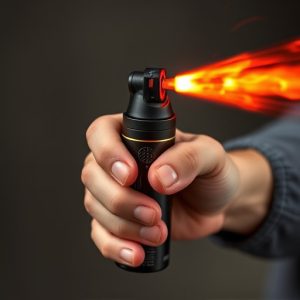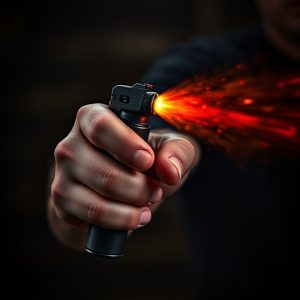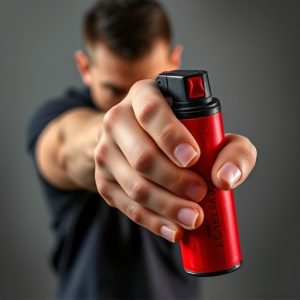Mastering Bear Spray Application: Techniques for Optimal Defender Effectiveness
Understanding aerosol spray dynamics is vital for defense against attackers, especially bears. The b…….
Understanding aerosol spray dynamics is vital for defense against attackers, especially bears. The best bear spray techniques involve aimed spraying at the attacker's face and neck for quick irritation and immobilization. Key factors in selection include bear species, desired spray pattern, capsaicin concentration, and weather conditions. Optimal application involves maintaining a 2-3 foot distance, targeting eyes and face with swift bursts, and following post-spray procedures like moving away, observing symptoms, and washing affected areas. Practicing these techniques enhances safety during encounters.
In wild or urban environments, aerosol spray defense, particularly bear spray, offers a crucial tool against aggressive attackers. This comprehensive guide delves into the dynamics of aerosol spray, exploring how it neutralizes threats and protects users. We’ll navigate choosing the right bear spray, understanding best application techniques, and mastering targeting strategies for maximum effectiveness. Additionally, post-spray procedures are detailed to ensure safety and mitigate risks after deployment. Learn the art of using aerosol spray defense like a pro with these essential practices.
- Understanding Aerosol Spray Dynamics: How It Works Against Attackers
- Choosing the Right Bear Spray: Factors to Consider for Maximum Effectiveness
- Best Practices for Safe and Effective Application of Bear Spray
- Targeting Techniques: Directing Spray for Optimal Impact on Attackers
- Post-Spray Procedures: What to Do After Deploying Aerosol Defense
Understanding Aerosol Spray Dynamics: How It Works Against Attackers
Understanding Aerosol Spray Dynamics: How It Works Against Attackers
Aerosol spray, often in the form of bear spray, is a powerful defense mechanism designed to deter and incapacitate attackers temporarily. The key to its effectiveness lies in the unique dynamics of aerosol distribution. When deployed, the spray creates a cloud of fine droplets that quickly fill the immediate area. These droplets are propelled at high speeds, aiming to irritate and disorient the attacker’s eyes, nose, and throat. The precision and range of modern aerosol sprays enable users to target specific areas without endangering bystanders or themselves excessively.
The best bear spray application techniques emphasize aimed spraying, ensuring the droplets reach the attacker directly. Users should focus on the face and neck, key areas for rapid irritation and immobilization. Practice and familiarity with the spray’s range and dispersion patterns are vital to ensure its effectiveness in high-stress situations. Understanding how aerosol spray dynamics work allows users to make informed decisions, enhancing their safety and survival skills when facing potential attackers.
Choosing the Right Bear Spray: Factors to Consider for Maximum Effectiveness
When selecting bear spray, several factors determine its effectiveness during an encounter. Consider the type of bear you’re most likely to face; black bears and grizzly bears (brown bears) require different spray formulations due to variations in behavior and size. A can’s spray pattern and range are also critical; look for models that offer a wide, even misting for maximum coverage. Check the concentration of capsaicin, the main active ingredient, which determines its potency—higher concentrations provide longer protection.
Additionally, consider weather conditions as they impact the best bear spray application techniques. In windy areas, opt for cans with a narrow spray pattern to direct the spray accurately at the bear’s face. Conversely, in humid environments, choose sprays with higher concentrations to ensure the chemical solution stays effective. Always follow safety guidelines and practice using the spray before venturing into potential bear country.
Best Practices for Safe and Effective Application of Bear Spray
When using aerosol spray for defense, understanding the best practices ensures its safety and effectiveness. For optimal results, users should maintain a close distance, typically 2-3 feet away from the attacker, and aim for the face and eyes. The key is to deploy the spray in quick bursts, allowing enough time between each burst for the target to become temporarily blinded and disoriented but not giving them a chance to retaliate.
Proper training on bear spray application techniques is crucial. Practicing with an instructor can help individuals learn how to use the spray efficiently without wasting valuable seconds. Always read and follow the instructions provided by the manufacturer, ensuring proper handling and storage of the canister afterward.
Targeting Techniques: Directing Spray for Optimal Impact on Attackers
When using aerosol spray for defense, understanding how to direct the stream is key to its effectiveness. The best bear spray application techniques focus on aiming for the face and eyes, as these areas are sensitive and crucial for an attacker’s senses. Squirting directly at the assailant’s face can cause temporary blindness, disorientation, and severe pain, providing an opportunity to escape or disable the attacker.
Practicing proper technique involves holding the canister at arm’s length and targeting slightly above and in front of the opponent’s nose. A swift, steady motion ensures the spray covers the desired area effectively. It’s important to note that bear spray is best used as a last resort; however, mastering these techniques can enhance personal safety during encounters with aggressive animals or individuals.
Post-Spray Procedures: What to Do After Deploying Aerosol Defense
After deploying aerosol spray defense, it’s crucial to follow immediate post-spray procedures for optimal protection and safety. The first step is to immediately move to a safe distance, ensuring you are at least 20 feet away from the attacker. This prevents further exposure to the spray and allows for clear assessment of the situation. Take a moment to observe any changes in behavior or symptoms in yourself and others present, as aerosol sprays can cause temporary blindness, coughing, or difficulty breathing.
Next, wash the affected areas thoroughly with soap and water to remove any residual spray. This is essential, especially if you’ve made contact with the attacker’s eyes or open wounds. Seek medical attention promptly if needed, as some bears spray formulations may require specific treatments for severe reactions. For best bear spray application techniques, remember the recommended range of 2-3 seconds, aiming for the face and chest area of the attacker. Proper usage ensures maximum effectiveness while minimizing off-target effects.
Equipped with knowledge of aerosol spray dynamics, the right bear spray, and best application techniques, individuals can defend against potential attackers effectively. Understanding targeting strategies and post-spray procedures further enhances safety. By following these practices, users can ensure maximum effectiveness while prioritizing their well-being in bear country or other high-risk environments. Choosing the appropriate bear spray and learning proper application techniques are key steps towards becoming better prepared for unexpected encounters.


